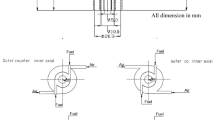Conclusions
-
1.
The deposit-forming tendency of diesel fuels can be assessed in the laboratory by their maximal nonsmoking flame height (MNFH), GOST 4338-48.
-
2.
The deposit-forming tendency of diesel fuels, which is a function of their hydrocarbon type composition, can be expressed by their ring coefficient.
Similar content being viewed by others
Literature cited
N. G. Puchkov, Diesel Fuels [in Russian], Gostoptekhizdat, Moscow (1953).
E. S. Starkman, A. G. Cattenco, and S. H. McAllister, Ind. Eng. Chem.,43, No. 12, 2822 (1951).
C. Boefhouwer and H. I. Waterman, J. Inst. Petroleum,40, No. 364, 116 (1954).
K. Van Nes and H. Van Westen, The Composition of Lubricating Oil Fractions of Petroleum and Their Analysis [Russian translation], IL, Moscow (1954).
Additional information
Translated from Khimiya i Tekhnologiya Topliv i Masel, No. 9, pp. 54–55, September, 1968.
Rights and permissions
About this article
Cite this article
Sobolev, E.P., Rubinshtein, I.A., Smirnov, M.S. et al. Laboratory method for assessing the deposit-forming tendency of diesel fuels. Chem Technol Fuels Oils 4, 695–697 (1968). https://doi.org/10.1007/BF00724231
Issue Date:
DOI: https://doi.org/10.1007/BF00724231




